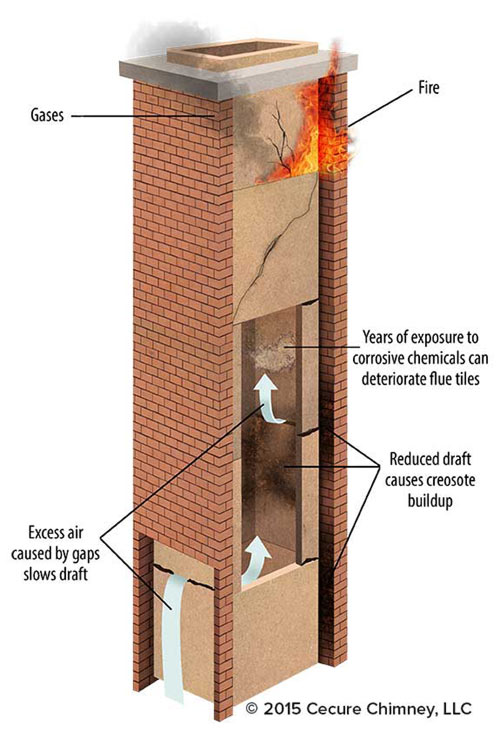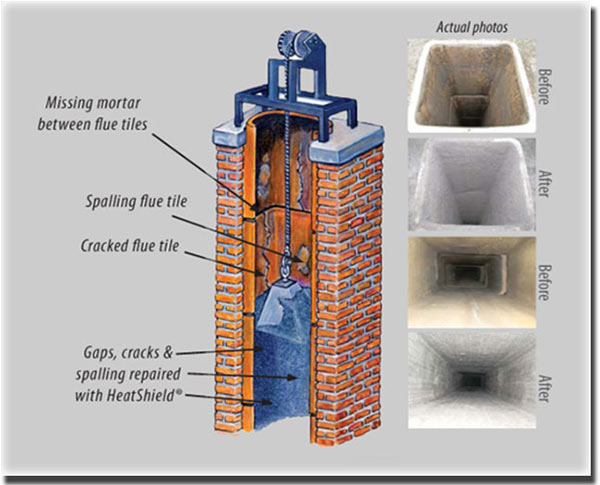How Flues Get Damaged and Options for Flue Repairs
Flue Damage and Fire Hazards
Chimney liners or flues, are designed to carry the products of combustion from fires safely out of the home. Damaged chimney liner flue tiles allow toxic gases (smoke), heat and fire to escape into the outer structure of your chimney where it can be a hazard to your health and home.
Gaps in flue tile joints and cracked flue tiles also allow outside air into the flue. This slows the chimney’s draft and cools the smoke which causes accelerated creosote accumulation and a weak draft which can cause smoking into the home. Creosote buildup in the flue is the #1 cause of chimney fires.
Gaps, cracks and spalling in a chimney flue are serious fire hazards and should not be taken lightly. Damaged flues can and do burn down thousands of homes in the US every year. If you have had a chimney fire or haven’t had your annual chimney inspection and cleaning, you should call a certified chimney sweep company to get your chimney checked before building your next fire. If your flue is damaged you shouldn’t build a fire in your fireplace until the flue is repaired.

How Chimney Liners Get Damaged
There are two ways a chimney liner can get damaged. Damage over time from the elements and damage from an event.
Water can degrade chimney mortar over time and cause it to dissolve or crumble. Moisture mixed with creosote in your chimney is corrosive and this speeds up the rate of deterioration. The most common damage from the elements in a flue is to the mortar between the flue tiles. Crumbled flue tile joint mortar leaves gaps which allow heat and the products of combustion to escape. This is one of the reasons it is important to get your chimney waterproofed. A leaking chimney isn’t necessarily a fire code issue but it can cause them.
Events that damage chimney liners come in different forms. Storm damage such as a tree striking a chimney can break flue tiles but the most common damaging event is from chimney fires. Chimneys fires crack flue tiles through thermal stress. Clay flue tiles are designed to contain the products of combustion, not fire. The high temperature of a chimney fire causes flue tiles to try to expand beyond their capacity and cracks them. If your home survives, your chimney will need to be inspected before the next fire is built. It is important to get your chimney cleaned and inspected annually to reduce the risk of chimney fires.
Chimney Flue Repair Methods
Chimney Rebuilding
Before some of the advancements in modern chimney technology, the only way to repair a damaged chimney liner was to tear down and rebuild the chimney from the lowest damaged flue tile. If the bottom flue tile was damaged that meant tearing the chimney all the way down to the fireplace and rebuilding from there up. Rebuilding chimneys is extremely expensive. While this is still done on some chimneys that are so far gone they are not worth repairing, there are other options available today that offer a less costly alternative to rebuilding.
HeatShield® Cerfractory Flue Repair
HeatShield® Cerfractory Flue Repair treatment is one of the newer methods to repair chimney liners and one of the most advanced. It can be used to repair flue tile mortar gaps only or to resurface a flue with cracked or damaged tiles. HeatShield also comes with a lifetime warranty if a chimney is fully waterproofed with a full cover cap, flashing sealant and exterior waterproofing. At A-1 Chimney Pro, this is the preferred method for masonry chimney liner repair for a number of reasons.

- It is more cost effective than rebuilding.
- HeatShield is non-destructive. Sometimes relining requires the removal of some if not all flue tiles. Breaking out flue tiles is a huge mess and can cause unintentional damage to a home. HeatShield does not require tile removal.
- It minimizes inner flue ID reduction. Relining reduces the inner diameter of the flue making it more constrictive and increases the chance of draft problems. HeatShield resurfaces the existing tiles with less flue ID reduction than relining.
- HeatShield improves chimney performance by eliminating outside air coming in through gaps and cracks which slow and cool smoke.
- It provides an extra layer of insulation in addition to the existing flue tiles. This helps protect your home better by preventing heat transfer outside the flue. It also improves draft by keeping smoke hotter inside the flue so it rises faster out of the chimney.
- It’s super stuff! HeatShield is rated “Super-Duty” exceeding both IRC and NFPA code requirements, which specify only medium-duty.
- It can handle the heat. HeatShield is rated to 2900 degrees which is above the temperature of most chimney fires. This provides more protection should a homeowner have a chimney fire in the future.
Note: Not all chimneys may be eligible for HeatShield treatment. If a chimney flue has tiles that are too offset or if large pieces are missing, relining is the next option.
Chimney Relining
Chimney relining, specifically with an inserted liner, consists of a stainless steel alloy tube inserted into the chimney flue and surrounded by insulation. Insulation may either be a poured refractory type mortar or a ceramic wool insulating blanket may be used if flue tiles are missing.
Since relining reduces the volume of the flue inner net free area, careful measurements have to be made by an educated technician to determine the size of liner needed in relation to the fireplace opening. If a chimney liner isn’t big enough the chimney will not draft properly. Fortunately, a round flue drafts better than a square flue and most chimneys can readily accept a liner of the appropriate size with minimal disturbance to the existing flue tiles. However, sometimes the existing clay flue tile chimney liner is already at its minimum capacity and the tiles will need to be broken out so the chimney can accept a larger stainless steel liner.
In the case of very small chimneys where the outside diameter of the chimney is too small to accept an appropriately sized liner, the only option may be to rebuild the chimney.

Request an Appointment
Contact us to set up an appointment to get your chimney inspected and find out the options available.
